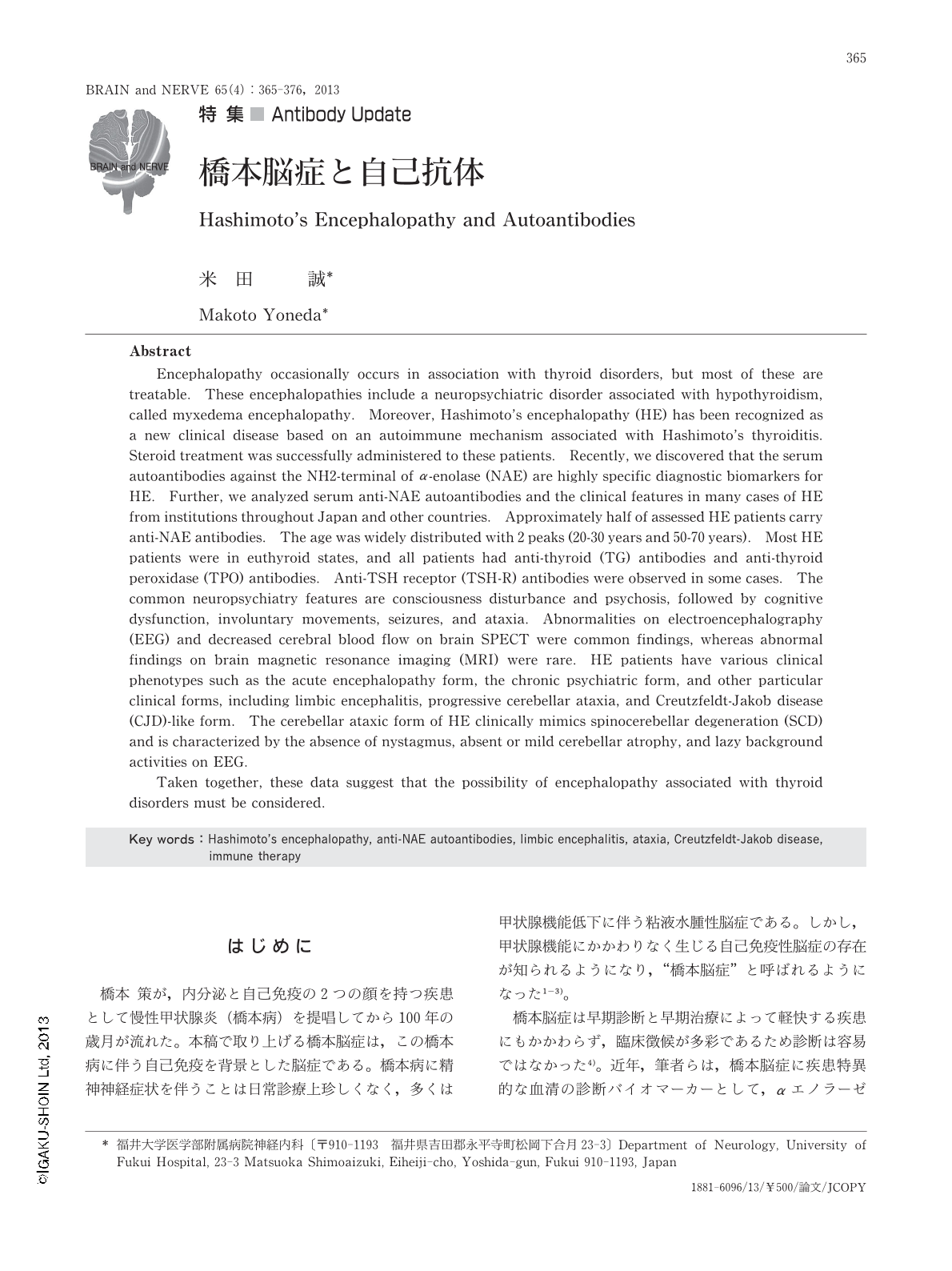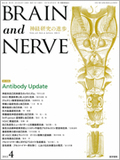Japanese
English
- 有料閲覧
- Abstract 文献概要
- 1ページ目 Look Inside
- 参考文献 Reference
はじめに
橋本 策が,内分泌と自己免疫の2つの顔を持つ疾患として慢性甲状腺炎(橋本病)を提唱してから100年の歳月が流れた。本稿で取り上げる橋本脳症は,この橋本病に伴う自己免疫を背景とした脳症である。橋本病に精神神経症状を伴うことは日常診療上珍しくなく,多くは甲状腺機能低下に伴う粘液水腫性脳症である。しかし,甲状腺機能にかかわりなく生じる自己免疫性脳症の存在が知られるようになり,“橋本脳症”と呼ばれるようになった1-3)。
橋本脳症は早期診断と早期治療によって軽快する疾患にもかかわらず,臨床徴候が多彩であるため診断は容易ではなかった4)。近年,筆者らは,橋本脳症に疾患特異的な血清の診断バイオマーカーとして,αエノラーゼのN末端領域に対する自己抗体(抗NAE抗体;NH2-terminal of alpha-enolase)を見出し,血清診断が初めて可能となった5,6)。現在,筆者らの施設に全国から多数の抗NAE抗体解析の依頼があり,それらの臨床的解析から橋本脳症の臨床像の全貌が明らかになりつつある。本稿では,筆者らの多数症例の検討から見出された橋本脳症の臨床的特徴を自己抗体との関連から述べる。
Abstract
Encephalopathy occasionally occurs in association with thyroid disorders, but most of these are treatable. These encephalopathies include a neuropsychiatric disorder associated with hypothyroidism, called myxedema encephalopathy. Moreover, Hashimoto's encephalopathy (HE) has been recognized as a new clinical disease based on an autoimmune mechanism associated with Hashimoto's thyroiditis. Steroid treatment was successfully administered to these patients. Recently, we discovered that the serum autoantibodies against the NH2-terminal of α-enolase (NAE) are highly specific diagnostic biomarkers for HE. Further, we analyzed serum anti-NAE autoantibodies and the clinical features in many cases of HE from institutions throughout Japan and other countries. Approximately half of assessed HE patients carry anti-NAE antibodies. The age was widely distributed with 2 peaks (20-30 years and 50-70 years). Most HE patients were in euthyroid states, and all patients had anti-thyroid (TG) antibodies and anti-thyroid peroxidase (TPO) antibodies. Anti-TSH receptor (TSH-R) antibodies were observed in some cases. The common neuropsychiatry features are consciousness disturbance and psychosis, followed by cognitive dysfunction, involuntary movements, seizures, and ataxia. Abnormalities on electroencephalography (EEG) and decreased cerebral blood flow on brain SPECT were common findings, whereas abnormal findings on brain magnetic resonance imaging (MRI) were rare. HE patients have various clinical phenotypes such as the acute encephalopathy form, the chronic psychiatric form, and other particular clinical forms, including limbic encephalitis, progressive cerebellar ataxia, and Creutzfeldt-Jakob disease (CJD)-like form. The cerebellar ataxic form of HE clinically mimics spinocerebellar degeneration (SCD) and is characterized by the absence of nystagmus, absent or mild cerebellar atrophy, and lazy background activities on EEG.
Taken together, these data suggest that the possibility of encephalopathy associated with thyroid disorders must be considered.

Copyright © 2013, Igaku-Shoin Ltd. All rights reserved.


